Related Research Articles

A cherry is the fruit of many plants of the genus Prunus, and is a fleshy drupe.
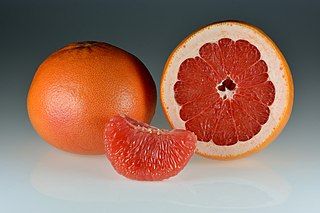
The grapefruit is a subtropical citrus tree known for its relatively large, sour to semi-sweet, somewhat bitter fruit. The interior flesh is segmented and varies in color from pale yellow to dark pink.

Fruit tree propagation is usually carried out vegetatively (non-sexually) by grafting or budding a desired variety onto a suitable rootstock.

Prunus cerasus is a species of Prunus in the subgenus Cerasus (cherries), native to much of Europe and southwest Asia. It is closely related to the sweet cherry, but has a fruit that is more acidic. Its sour pulp is edible.

Carambola, also known as star fruit, is the fruit of Averrhoa carambola, a species of tree native to tropical Southeast Asia. The mildly poisonous fruit is commonly consumed in parts of Brazil, Southeast Asia, South Asia, the South Pacific, Micronesia, parts of East Asia, the United States, and the Caribbean and contains the neurotoxin caramboxin. The tree is cultivated throughout tropical areas of the world.

Prunus serotina, commonly called black cherry, wild black cherry, rum cherry, or mountain black cherry, is a deciduous tree or shrub of the genus Prunus. Despite being called black cherry, it is not very closely related to the commonly cultivated cherries such as sweet cherry, sour cherry and Japanese flowering cherries which belong to Prunus subg. Cerasus. Instead, P. serotina belongs to Prunus subg. Padus, a subgenus also including Eurasian bird cherry and chokecherry. The species is widespread and common in North America and South America.
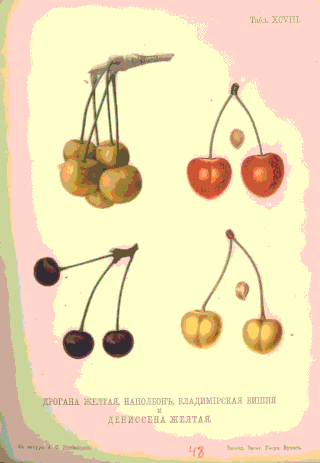
The Royal Ann or Royal Anne is a variety of cherry, similar in appearance and taste to the 'Rainier cherry'.
A rootstock is part of a plant, often an underground part, from which new above-ground growth can be produced. It could also be described as a stem with a well developed root system, to which a bud from another plant is grafted. It can refer to a rhizome or underground stem. In grafting, it refers to a plant, sometimes just a stump, which already has an established, healthy root system, onto which a cutting or a bud from another plant is grafted. In some cases, such as vines of grapes and other berries, cuttings may be used for rootstocks, the roots being established in nursery conditions before planting them out. The plant part grafted onto the rootstock is usually called the scion. The scion is the plant that has the properties that propagator desires above ground, including the photosynthetic activity and the fruit or decorative properties. The rootstock is selected for its interaction with the soil, providing the roots and the stem to support the new plant, obtaining the necessary soil water and minerals, and resisting the relevant pests and diseases. After a few weeks, the tissues of the two parts will have grown together, eventually forming a single plant. After some years, it may be difficult to detect the site of the graft although the product always contains the components of two genetically different plants.

Honeycrisp is an apple cultivar developed at the Minnesota Agricultural Experiment Station's Horticultural Research Center at the University of Minnesota, Twin Cities. Designated in 1974 with the MN 1711 test designation, patented in 1988, and released in 1991, the Honeycrisp, once slated to be discarded, has rapidly become a prized commercial commodity, as its sweetness, firmness, and tartness make it an ideal apple for eating raw. "...The apple wasn't bred to grow, store or ship well. It was bred for taste: crisp, with balanced sweetness and acidity." It has larger cells than most apple cultivars, a trait which is correlated with juiciness, as theoretically a higher number of cells rupture when bitten, releasing more juice in the mouth. The Honeycrisp also retains its pigment well and has a relatively long shelf life when stored in cool, dry conditions. Pepin Heights Orchards delivered the first Honeycrisp apples to grocery stores in 1997. The name Honeycrisp was trademarked by the University of Minnesota, but university officials were unsure of its protection status in 2007. It is now the official state fruit of Minnesota. A large-sized honeycrisp will contain about 113 calories.

The Evans Cherry also sold under the name 'Bali', is a sour cherry cultivar rediscovered in an old orchard near Edmonton, Alberta, Canada, and is significant because cherries were not considered viable in the harsh climate of the Canadian prairies, yet the specimen, discovered by Ieuan Evans, had been growing there since the 1920s. Grown on its own rootstock and self-pollinating, the Evans Cherry displays white blossoms in spring and bears abundant fruit.
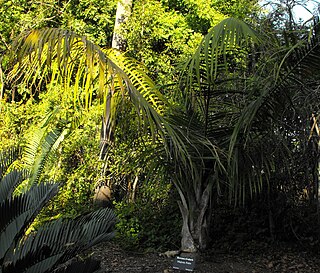
Ravenea rivularis, the majestic palm, or majesty palm, is a species of tree in the family Arecaceae. They generally grow to 10 to 12 feet tall and are often marketed in stores as a "houseplant" in a pot, in its natural state, the majesty palm may sometimes grow to 98 feet tall.

Prunus fruticosa, the European dwarf cherry, dwarf cherry, Mongolian cherry or steppe cherry is a deciduous, xerophytic, winter-hardy, cherry-bearing shrub. It is also called ground cherry and European ground cherry, but is not to be confused with plants in the distinct "Groundcherry" genus of Physalis.

Prunus tomentosa is a species of Prunus native to northern and western China, Korea, Mongolia, and possibly northern India. Common names for Prunus tomentosa include Nanjing cherry, Korean cherry, Manchu cherry, downy cherry, Shanghai cherry, Ando cherry, mountain cherry, Chinese bush cherry, and Chinese dwarf cherry.

Prunus avium, commonly called wild cherry, sweet cherry, gean, or bird cherry is a species of cherry, a flowering plant in the rose family, Rosaceae. It is native to Europe, Anatolia, Maghreb, and Western Asia, from the British Isles south to Morocco and Tunisia, north to the Trondheimsfjord region in Norway and east to the Caucasus and northern Iran, with a small isolated population in the western Himalaya. The species is widely cultivated in other regions and has become naturalized in North America and Australia.
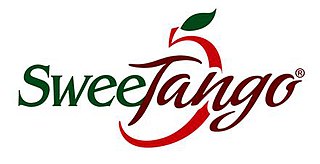
SweeTango is the brand designation of the cultivated apple 'Minneiska'. It is a patented cross breed between the 'Honeycrisp' and the Zestar! apple. The trademark name belongs to the University of Minnesota. The apple is controlled and regulated for marketing, allowing only exclusive territories for growing. It has a sweet-tart taste that some food writers have described as something between brown sugar and spiced apple cider.
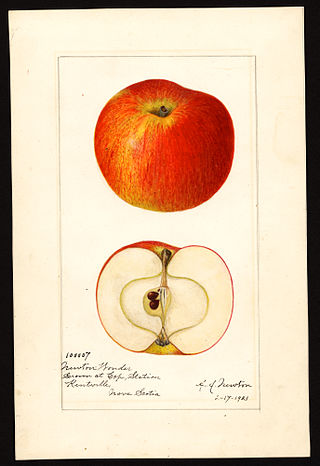
Malus domestica Newton Wonder is a cultivar of apple which is usually eaten cooked due to its sourness. The variety has a similar but slightly sweeter taste than the Bramley apple and is usually used in pies or as a preserve.
Wonka Gummies are a line of gummy sweets made by The Willy Wonka Candy Company. They were launched in 2009 and are available in 155.9g/5.5 ounce bags. The Sluggles, Puckerooms, Wingers, and Sploshberries were previously marketed as coming from Wonka's edible garden, up until November 2010.

Cherry leaf spot is a fungal disease which infects cherries and plums. Sweet, sour, and ornamental cherries are susceptible to the disease, being most prevalent in sour cherries. The variety of sour cherries that is the most susceptible are the English morello cherries. This is considered a serious disease in the Midwest, New England states, and Canada. It has also been estimated to infect 80 percent of orchards in the Eastern states. It must be controlled yearly to avoid a significant loss of the crop. If not controlled properly, the disease can dramatically reduce yields by nearly 100 percent. The disease is also known as yellow leaf or shothole disease to cherry growers due to the characteristic yellowing leaves and shot holes present in the leaves upon severe infection.
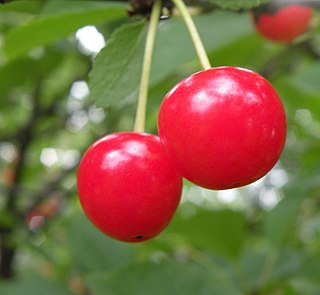
Cherry production in Michigan is a major part of the agriculture industry in the state. Harvesting over 90,000 tons of cherries each year, Michigan is the nation's leading producer of tart cherries. The Montmorency cherry is the variety of tart, or sour, cherry most commonly grown in the state. A Hungarian sour cherry cultivar, Balaton, has been commercially produced in Michigan since 1998.
Garcinia parvifolia, the Kundong, Brunei cherry or Asam aur aur, is a tropical evergreen tree native to Borneo, Peninsular Malaysia, Sulawesi and Sumatra. The tree is found at elevations of 600–800 metres (2,000–2,600 ft) in humid environments, and grows to a height of 33 metres (108 ft). The bark, wood, leaves, and fruit of the kundong tree are used by humans.
References
- ↑ "Canadian Dwarf Sour Cherries – Prunus x kerrasis — Carrington REC". ag.ndsu.edu. Retrieved 2016-11-01.
- ↑ "Growing Cherries in the Home Garden | Horticulture and Home Pest News". ipm.iastate.edu. Retrieved 2016-11-01.
- ↑ "Want to try planting a cherry tree? | Lifestyles | qctimes.com". qctimes.com. Retrieved 2016-11-01.
- ↑ "Stone fruits for Minnesota gardens". extension.umn.edu. Retrieved 2016-11-01.
- ↑ "Growing Sour Cherries". Agriculture Research Service: USDA. Retrieved 2016-11-01.
- ↑ "Growing cherries on the Colorado Front Range - CSMonitor.com". csmonitor.com. Retrieved 2016-11-01.
- ↑ "Tart Varieties — Fruit Production for the Home Gardener — Penn State Extension". extension.psu.edu. Retrieved 2016-11-01.
- ↑ "Dara Moskowitz Grumdahl's Top 5 Cherry Recipes « WCCO | CBS Minnesota". minnesota.cbslocal.com. Retrieved 2016-11-01.
- ↑ "Growing & Caring for Sour Cherry Trees | Home Guides | SF Gate". homeguides.sfgate.com. Retrieved 2016-11-01.
- ↑ "Propagation of Sour Cherries | Home Guides | SF Gate". homeguides.sfgate.com. Retrieved 2016-11-01.
- ↑ "Southern Indiana grown cherries are tart and sweet". archive.courierpress.com. Retrieved 2016-11-01.
- ↑ "Hurrah for sour cherries! « All In". blogs.northcountrypublicradio.org. Retrieved 2016-11-01.
- ↑ "The best backyard fruit trees for New England - The Boston Globe". bostonglobe.com. Retrieved 2016-11-01.
- ↑ "Will Travel for Food: Michigan Cherries | Community Blogs | nwitimes.com". nwitimes.com. Retrieved 2016-11-01.
